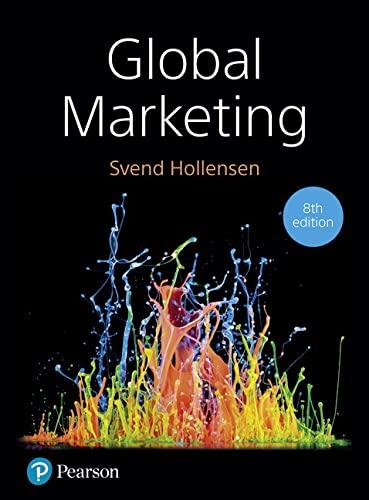Creating products to save peoples lives in the developing world is the mission of a company
Question:
Creating products to save people’s lives in the developing world is the mission of a company – Vestergaard-
Frandsen (VF) (www.vestergaard-frandsen.
com) – based in Lausanne, Switzerland. The ‘profit for a purpose’ approach has turned humanitarian responsibility into VF’s core business. The company is offering complex emergency response and disease-
control products.
Vestergaard Frandsen began life over 60 years ago in Denmark as a modest manufacturer of hotel and restaurant uniforms. Today, its headquarters are in Lausanne, and the sole focus of the 140 employees is on what the CEO Mikkel Vestergaard Frandsen calls ‘humanitarian entrepreneurship’.
Originally a textile company that began in Denmark in 1957, they now develop innovative products that prevent the transmission of water-borne and insect-borne diseases in developing countries.
For water-borne diseases VF has its LifeStraw – see below for a description. For insect-borne diseases VF is one of the world’s leading producers of bed nets impregnated with insecticide. The purpose is to prevent malaria, caused by the bloodsucking bites of mosquitoes. Besides mosquito intensive areas, this product is used in refugee camps and disaster areas all over the world. Vestergard Frandsen, which is family-owned, does not disclose financial data, but over the years it has sold over 280 million mosquito nets, and the company makes a profit.
The concept for the LifeStraw began with the work of the Carter Center, founded by Jimmy and Rosalynn Carter. It has been their mission since 1986 to eradicate guinea worm disease (GWD) in Africa and Asia. The most effective way to prevent this disease is to filter drinking water, so that the tiny water fleas are not ingested to begin the life cycle of GWD.
The LifeStraw has played a substantial role in the prevention of this disease, and many other bacterial and viral infections caused by a lack of safe drinking water in many developing countries.
The lack of safe drinking water Water in drinking form is becoming scarcer in certain places, and its availability is a major social and economic concern. Currently, about a billion people around the world routinely drink unhealthy water.
About 99.7 per cent of the Earth’s water is contained in undrinkable forms such as oceans, underground, ice caps and glaciers. Due to increased contamination and pollution both above and below the ground, the condition of the remaining 0.3 per cent is now questionable, with many countries finding it increasingly difficult to source drinkable water that is of an acceptable quality.
Throughout history, clashes between and within countries have occurred over water and its supply.
Many people believe that in the future conflicts and even wars will be waged over water supplies, particularly as uncontaminated water becomes increasingly scarce.
More than 780 million people in the world do not have access to safe drinking water. The average distance that women in Africa and Asia walk to collect water is 6 km.
The LifeStraw product LifeStraw water filters remove disease-causing pathogens that are major causes of water-borne diseases such as cholera, typhoid and diarrhoea in the developing world, enabling people to access safe drinking water. LifeStraw technologies have been distributed to more than 65 countries where they are a vital tool for some of the 800 million people who don’t have ready access to safe drinking water.
LifeStraw filters are easy to use, and require no electricity, batteries or replacement parts. The personal version is ideal for out-of-home use by hikers, campers or people displaced by natural disasters.
LifeStraw Family, used in homes, provides an average family of five with safe water for at least three years. LifeStraw Community is designed for schools, health facilities and institutions where it will deliver an estimated 70,000 to 100,000 litres of safe drinking water over its lifetime.
Five million people die each year (mainly children)
from water-borne diseases. The World Health Organization (WHO) estimates that safe water could prevent 1.4 million child deaths from diarrhoea each year.

product as simple and inexpensive as the LifeStraw could change these numbers and do it right at the point of consumption.
How does the LifeStraw function?
LifeStraw uses advanced hollow fibre technology.
Water is forced through narrow fibres under high pressure. Clean water exits through tiny pores in the walls of the hollow fibres, but bacteria, protozoa and other contaminants are trapped inside the hollow fibres and are flushed out by backwashing. This is a highly efficient method of filtration.
For the personal version of LifeStraw, the user draws the unfiltered water through the LifeStraw, the same way they would when using a straw.
For LifeStraw Family and LifeStraw Community, untreated water is poured into the top of the unit which has a pre-filter that removes coarse particles.
The ultrafiltration hollow-fibre membrane cartridge then stops all turbidity particles and smaller pathogens, including all bacteria, viruses and protozoan cysts. Particles and microbes larger than 20 nanometres stay on the dirty side of the membrane and clean/purified water passes through the membrane. The blue tap releases purified water.
Customers and distribution of LifeStraw Customers are mainly foreign governmental aid agencies, international relief and development organizations, foundations and charities.
The best way for people (end users) in these risky areas to get a LifeStraw is through a charitable organization, which funds and sometimes also buys the products. The non-governmental organizations (NGOs) then take the product to the rural households where the poorest people live.
Questions
1. In McNeil (2009), Kevin Starace states: ‘Vestergaard is just different from other companies we work with. They think of end users as a consumer rather as a patient or a victim.’ What do you think is the meaning behind this statement?
2. What are the most critical factors in the further internationalization process of Vestergaard Frandsen?
Step by Step Answer:






